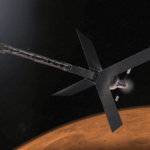Late last year, analysis of old data from a 1978 Pioneer probe that reached our neighbouring planet, Venus, came up with an interesting discovery. The existence of phosphine, a hydrogen-phosphorus compound, was detected in the planet’s atmosphere. If the gas was there then a number of scientists speculated that this was a sign of life.
We know that the environment at the surface of Venus resembles what some describe as the depiction of hell. Hot enough (482 Celsius or 900 Fahrenheit) to melt metal with atmospheric pressure that would crush anything landing on its surface, Venus appears to be the epitome of an uninhabitable environment.
Yet the existence of trace amounts of phosphine, an exhalation byproduct of life here on Earth, was extracted from the data. Described as a subtle presence, it suggested that something in the Venusian atmosphere had to be producing it. Could Venus have a habitability band in its atmosphere where temperatures were sufficiently lower to allow for some form of microbial life to exist? It appears that such an environment does exist from 48 and 60 kilometers (30 to 37 miles) above the planet’s surface where temperatures from -1 to 93 Celsius (30 to 200 Fahrenheit) are found.
Could an airborne life exist that survived the runaway greenhouse effect that turned Venus more than a billion years ago into what it is today? The amount of phosphine detected through the data is not significant and may have a non-organic source. Some scientists speculate it may come from volcanic eruptions or lightning discharges in the planet’s atmosphere.
Nonetheless, it illustrates the point of this posting, that we continue to search for life elsewhere while despoiling the life right under our noses.
Where else are we looking for life or evidence of its past alien existence? On Enceladus and Titan, two moons of Saturn. On Europa, a moon of Jupiter. On Ceres, the largest asteroid in our Solar System, and on Mars. The latter has been the prime candidate in the search for extraterrestrial life going back to the first Viking landers in 1976 which sent back soil test results that are still being debated to this day. Viking discovered organic molecules but did that mean Mars had life. Since Viking, NASA has sent landers and rovers to the planet’s surface never explicitly looking for life, but for environmental clues of habitability in the past. Perseverance, the NASA rover that is scheduled to touch down on the planet’s surface in February may take us closer to finding Martian microbes. But even Perseverance doesn’t include experiments that would definitively show us that Martian life in the present exists.
Europa, on the other hand, is an ice and ocean world with the potential for life under its crust. Should NASA proceed with its Europa Clipper orbiter mission planned for the mid-2020s, we may begin to understand the chemistry in its ocean as we sample eruptions of what appears to be water from fissures and cracks on the moon’s surface. Undoubtedly, finding organics in these emanations will lead to a future lander with the ability to drill below the surface to find isolated pockets of water where life may exist. A similar mission could be mounted to Enceladus or Ceres both ice bodies with hidden oceans beneath the surface crust.
With Titan whose geochemistry appears unique in our Solar System, we may have the potential for alien life to have emerged from a hydrocarbon environment where liquid methane seas lap continents made of water-ice, and where methane rains fill lakes and rivers flowing into larger bodies while under the surface a water ocean exists. Titan is the closest analog to Earth in our local neighbourhood but based on exotic chemistry. Would we even recognize Titanians as living things should we send probes to fly through its thick atmosphere, rove across its surface, or sail its seas?
All of this quest to find life elsewhere, and Elon Musk’s dream to build a city on Mars for a million of us, may whet our curiosity and pioneering spirit. But here on Earth, we have a task in hand to address the risk our human civilization is doing to our homeworld, the one place that we know for sure is habitable, and has a rich biodiverse history.
When 2020 ended we set another dubious record. We tied 2016 for the warmest atmospheric mean temperatures recorded since the dawn of the Industrial Revolution. The decade from 2010 to 2020 turned out to be the hottest since the late-19th century, and six years of the ten were the hottest on record.
Over this same period, the biomass of animals and plants continued to shrink with coral reefs dying, rainforests desiccating into savannah, increased desertification, river systems drying out, alpine glaciers vanishing, and polar sea ice showing a rapid decline. Our human actions have caused the biomass of mammals in the wild to shrink by 82% because of encroachment and exploitation. A third of all marine species showed a pronounced decline. And insects, the measure of environmental health, saw population crashes. If we are killing off the insects, just how dire is the continued existence of life on this planet?
In a United Nations report, Robert Watson, Chair of the Intergovernmental Science-Policy Platform on Biodiversity and Ecosystem Services, answers that last question stating “The health of the ecosystems on which we and other species depend is deteriorating more rapidly than ever. We are eroding the very foundations of economies, livelihoods, food security, health, and quality of life worldwide.”
I understand our quest to discover whether we are alone in the Universe, that our planet is not unique in having fostered rich biodiversity. But what I cannot contemplate is the billions we spend looking for life elsewhere without spending the many billions needed to ensure the life that we know exists continues to thrive here on Earth.
















